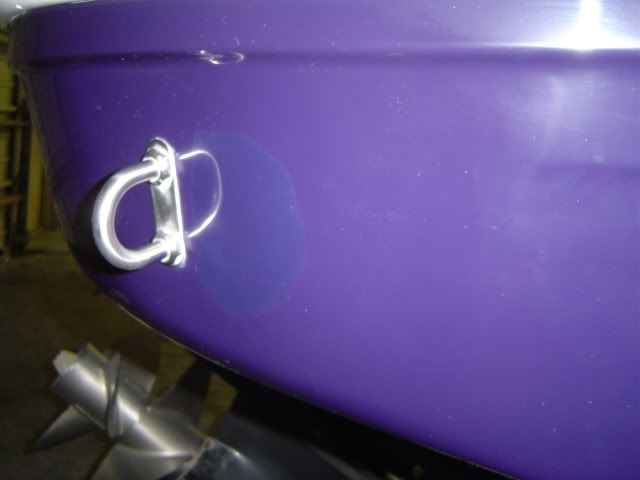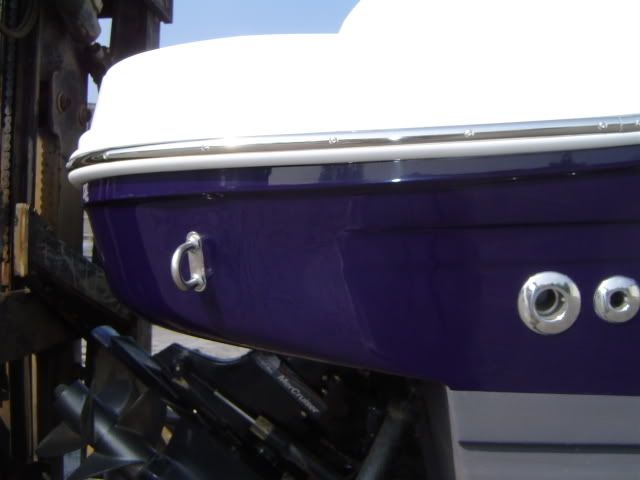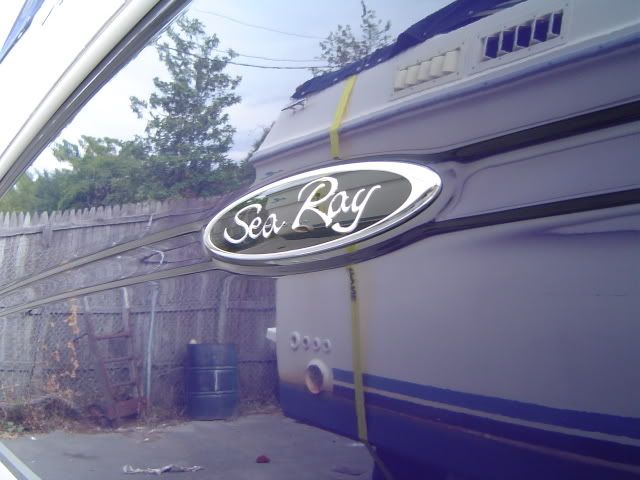When people give advice to others on how to care for their gelcoat, even though that advice may be well proven on certain color hulls, some of it can prove to provide less than satisfactory results on the Blue Purple gelcoats Sea Ray used on 2005, 2006 and 2007 hulls. In a recent posting where one of our members was looking at a used DA with a scratched blue hull, some of the advice given will not work properly. So I thought I would post what I have learned over the last 18 months with my Blue Purple hull and what I have seen at our Marina on other hulls of the same color.
I will not call myself an expert but I have made it a point to learn as much as I can and I have seen first hand what works and what doesn't with this color on my boat and on several others as well. The thing that makes this color so difficult to deal with is the fact that it looks different in different lighting conditions. And when it comes time for gelcoat work, that can prove challenging unless your fiberglass repair shop knows what they are doing. Frank Webster has mentioned his dealer orders a can of gelcoat by HIN number for each and every repair because that's the only way they found it will match properly. So be sure your own shop is knowledgeable about the quirks of this color before you let them proceed and obviously, you want to avoid a repair if at all possible.
But properly caring for your Blue Purple hull is just as important. And following some of the "time tested" methods that work on a white hull can damage your Blue/Purple hull. For example, if you have to wet sand the blue hull to remove a scratch, try not to use anything more aggressive than 1200 grit if at all possible and sand as lightly as possible and then follow that up with 2000 grit and finally some polishing compound. This is why you need to be carefull.............here is a spot on my boat that required sanding and this is what it looked like under a halogen light. The dealer did this and quite frankly I think they were too aggressive when they sanded.

I am not sure why this color variation exists but it is not visible under normal sunlight or daylight as is evidenced by this picture.

So be careful when you wet sand!! I have since wet sanded a number of other areas myself to remove minor scratches and I did it the way I mentioned above and did not have the same color variation issue as the picture above when I was done.
Next, if you use a rotary buffer on one of these hulls never use a wool bonnet! They will leave your hull full of swirl marks. Only use a foam pad on a Blue Purple hull when using a rotary polisher. Again, people find this out the hard way and then they have to compound the entire hull to get rid of the swirl marks. I have seen at least three hulls that suffered this fate. Interestingly enough you can use a wool pad with an Orbital buffer if necessary and not have swirls marks but I suggest you use a foam pad.
Next, the Blue Purple hull will look hazy under a halogen light or in certain direct lighting situations such as in the fall when the sun is low in the sky. You can't do anything about this. I have tried everything possible in the way of wet sanding, polishing, and buffing and nothing works. Having said that the hulls look very nice under most other lighting conditions as is evidenced by this photo. Although I don't have a picture of it this same area looks hazy (or cloudy) under a Halogen light.

As far as normal care of the blue hull goes, this is what I found works best for me after trying a myriad of products. I am not saying that other products aren't just as good because some are. I have an alternative product I use on occasion as well that I purchased from Proper Boat Care made by Gel Coat Labs. But Meguairs Flagship Wax has done the best job I found so far. It contains some mild polishing agents so when you apply it with an orbital buffer and a foam pad it will eliminate any minor scratches and water spotting on the hull. I typically apply the first coat with the Porter Cable Orbital and then wipe it off with a cotton towel and apply a second coat by hand and wipe it off (the second coat only takes about a half hour to apply and wipe off if you are thinking this is too much work :grin . This "wax" is really a polymer so it bonds to the gelcoat and will provide many months of protection. If you want to keep your hull nice and shiny, polish it a couple of times a year.
. This "wax" is really a polymer so it bonds to the gelcoat and will provide many months of protection. If you want to keep your hull nice and shiny, polish it a couple of times a year.
What about the occasional scratch you may get? Well you can wet sand it but I prefer to try compounding (by hand) first to see it that will take care of it. I use Mothers Mag and Aluminum polish because it seems to contain just the right amount of polishing compound to get the job done. Just remember this......whatever polish or compound you use only do a straight back and forth motion over the scratch or you will not like your results.
I will not call myself an expert but I have made it a point to learn as much as I can and I have seen first hand what works and what doesn't with this color on my boat and on several others as well. The thing that makes this color so difficult to deal with is the fact that it looks different in different lighting conditions. And when it comes time for gelcoat work, that can prove challenging unless your fiberglass repair shop knows what they are doing. Frank Webster has mentioned his dealer orders a can of gelcoat by HIN number for each and every repair because that's the only way they found it will match properly. So be sure your own shop is knowledgeable about the quirks of this color before you let them proceed and obviously, you want to avoid a repair if at all possible.
But properly caring for your Blue Purple hull is just as important. And following some of the "time tested" methods that work on a white hull can damage your Blue/Purple hull. For example, if you have to wet sand the blue hull to remove a scratch, try not to use anything more aggressive than 1200 grit if at all possible and sand as lightly as possible and then follow that up with 2000 grit and finally some polishing compound. This is why you need to be carefull.............here is a spot on my boat that required sanding and this is what it looked like under a halogen light. The dealer did this and quite frankly I think they were too aggressive when they sanded.

I am not sure why this color variation exists but it is not visible under normal sunlight or daylight as is evidenced by this picture.

So be careful when you wet sand!! I have since wet sanded a number of other areas myself to remove minor scratches and I did it the way I mentioned above and did not have the same color variation issue as the picture above when I was done.
Next, if you use a rotary buffer on one of these hulls never use a wool bonnet! They will leave your hull full of swirl marks. Only use a foam pad on a Blue Purple hull when using a rotary polisher. Again, people find this out the hard way and then they have to compound the entire hull to get rid of the swirl marks. I have seen at least three hulls that suffered this fate. Interestingly enough you can use a wool pad with an Orbital buffer if necessary and not have swirls marks but I suggest you use a foam pad.
Next, the Blue Purple hull will look hazy under a halogen light or in certain direct lighting situations such as in the fall when the sun is low in the sky. You can't do anything about this. I have tried everything possible in the way of wet sanding, polishing, and buffing and nothing works. Having said that the hulls look very nice under most other lighting conditions as is evidenced by this photo. Although I don't have a picture of it this same area looks hazy (or cloudy) under a Halogen light.

As far as normal care of the blue hull goes, this is what I found works best for me after trying a myriad of products. I am not saying that other products aren't just as good because some are. I have an alternative product I use on occasion as well that I purchased from Proper Boat Care made by Gel Coat Labs. But Meguairs Flagship Wax has done the best job I found so far. It contains some mild polishing agents so when you apply it with an orbital buffer and a foam pad it will eliminate any minor scratches and water spotting on the hull. I typically apply the first coat with the Porter Cable Orbital and then wipe it off with a cotton towel and apply a second coat by hand and wipe it off (the second coat only takes about a half hour to apply and wipe off if you are thinking this is too much work :grin
What about the occasional scratch you may get? Well you can wet sand it but I prefer to try compounding (by hand) first to see it that will take care of it. I use Mothers Mag and Aluminum polish because it seems to contain just the right amount of polishing compound to get the job done. Just remember this......whatever polish or compound you use only do a straight back and forth motion over the scratch or you will not like your results.


